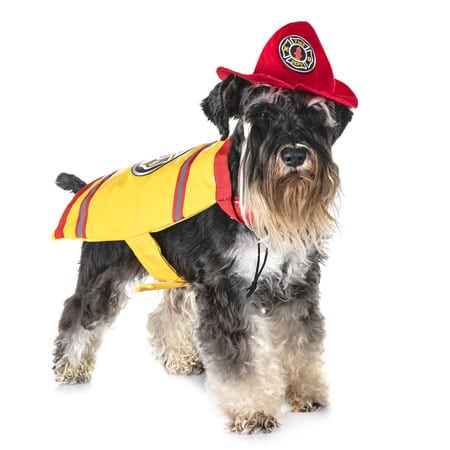Each year, more than 500,000 pets are affected by house fires. In order to prevent and prepare for a possible house fire, it is important to remember your pets when thinking about your fire preparedness plan.
Preventing a Fire
- Reduce open flame exposure – Pets are curious and may try to investigate your unattended candles or fireplace. Opt instead for flameless candles or an enclosed fireplace to prevent an accidental knock or escaped ember from burning out of control.
- Put covers on or remove stove knobs and discourage climbing in the kitchen – an accidental nudge of a stove knob is the number one cause of house fires started by pets. By preventing your pet from interacting with a stove, you can take a big step toward preventing fires.

- Secure loose wires – Pets may like to chew on wires and cords, but ensure that these items are out of reach from your pet, as they can lead to fires.
- Never put a glass bowl on a wooden porch – The sun’s rays can heat the bowl and cause a fire on your wooden deck. Opt instead for ceramic or stainless-steel dishes when outside.
Preparing for a Fire
- Include your pet into your family emergency plan and practice taking them with you. Talk with your family members to determine who is responsible for grabbing your pets and who should grab their supplies (food, medication, photo, leashes and carriers, medical records) during an emergency so you can reduce scrambling and redundancy when speed and efficiency are needed.
- Put a decal in your home’s front window indicating the number and type of pets you have – Providing this information can cut down on the time responders spend searching your home in the case of a fire.
- Make sure your pet’s updated contact information is reflected on their ID collar and in the microchip database – If your pet gets lost during a fire, this will help rescuers get her or him back to you.
- Use monitored smoke detectors that are connected to emergency responders – Should a fire start while you are away from your home, you’ll rest assured that your pet has access to emergency response services even if no one is home to call them.
- Know your pets’ hideaways and create ways for easy access to them in case of an emergency – It’s nice that your pet can get away if she or he wants to, but in an emergency, you need to be able to locate and extract your pet as quickly as possible.
During a Fire
- Attempt to grab your pet and exit the home as quickly as possible, but if it takes too long to locate or secure them, leave – You should never delay escape or endanger yourself or your family. Once responders get there, immediately inform them your pet is still inside, so they can go enter your home and continue looking for your pet.
- Grab leashes and carriers on your way out – Outside will be chaotic and that may cause your pet to try to escape to a calm, safe area.
- Never go back inside a burning house. If you can’t find your pet, leave, open the door, and call to them repeatedly from a safe distance away. Let firefighters take over the task of locating your pet.
Reference: American Humane
 Skip to content
Skip to content
